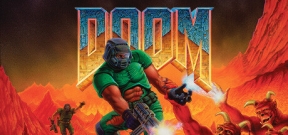
Delve into the fascinating world of the classic game Doom, a pioneer in the realm of first-person shooters, offering a gripping narrative and intense gameplay that has left a lasting legacy in the world of gaming. From its revolutionary graphics to its iconic soundtrack, Doom has truly stood the test of time, captivating players for decades. In this in-depth exploration, we will embark on a journey through the history of this legendary game, uncovering its origins, impact on the gaming industry, and the loyal fanbase that continues to celebrate its enduring appeal.
Tracing the Origins: Doom Classic Game
Play Doom Classic on Steam via 2Game!
Setting the Scene: The Era of 1993

The year 1993 marked a turning point in the gaming industry. At this time, most games were limited by technology, offering simple graphics and gameplay. The release of the Doom classic game was a monumental event that changed the landscape of gaming. It was a period when home computers were becoming more common, but they still lacked the raw power we see today. Against this backdrop, Doom's advanced graphics engine, which allowed for a pseudo-3D experience, was nothing short of revolutionary. It wasn't just a leap in technical achievement; it was a bold statement about the future of gaming. Doom set a new benchmark for what games could look like and how they could engage players, laying down the foundation for the genre of first-person shooters that would dominate gaming for years to come.
Prequel to DOOM: Id Software
Before Doom could take the world by storm, there was Id Software, the company behind the magic. Founded in 1991, Id Software quickly made a name for itself with titles like Wolfenstein 3D, which is often credited as one of the earliest first-person shooters. This small team of developers had a talent for pushing the boundaries of what was possible in computer games. John Carmack, John Romero, Adrian Carmack, and Tom Hall, the key figures at Id Software, were setting the stage for something extraordinary. Their collaboration and unique blend of skills created an environment ripe for innovation. This culminated in the development of Doom, a game that would utilise their proprietary game engine technology to deliver an unprecedented immersive experience. Id Software's ambition and technical prowess thus set the groundwork for Doom's creation, a game that would not only become a household name but also redefine an entire genre.
Building Blocks of DOOM: Design and Development
The creation of Doom was a complex process that involved groundbreaking design and development techniques. It started with the vision to create a game that was faster and more technologically advanced than anything before it. The developers at Id Software were determined to push the boundaries of the existing hardware, optimizing Doom to run smoothly on the computers of that era. They developed custom tools, like the Doom level editor, which allowed for the creation of intricate, multi-layered maps. This level editor was not only a tool for the developers but later became a catalyst for the modding community, contributing significantly to the game's longevity. The team also implemented a novel binary space partitioning algorithm, which made the rendering of the game's 3D spaces more efficient. All these elements, from the engine to the level design, coalesced to produce a game that was visually stunning, fast-paced, and engaging, setting a new standard in game development.
Game-Changer: Impact of Doom on Gaming Industry

Placing Id on the Map: Success Stories
The success of Doom was immediate and resounding, securing Id Software's place in gaming history. Within months of its release, it was reported that millions of people were playing Doom. It was not just the number of players that was impressive, but also the way in which the game was distributed. Doom was one of the first games to be shared widely through an early form of digital distribution and shareware, allowing players to try a portion of the game for free before purchasing the full version. This model proved to be incredibly successful, dramatically increasing the game's reach and fueling its popularity. It wasn't long before the game's success translated into significant financial achievements for Id Software, giving the company the resources and reputation to continue innovating in the gaming industry. Doom's success story remains a testament to the potential of great game design and smart marketing.
Widespread Influence: Opening Doors to FPS Games
Doom's impact extended well beyond its own commercial success; it played a pivotal role in shaping the future of first-person shooter (FPS) games. Before Doom, the FPS genre was in its infancy, with only a handful of examples, like Wolfenstein 3D, hinting at its potential. Doom, however, showcased what the genre could achieve in terms of excitement, game mechanics, and immersive storytelling. Its fast-paced action, combined with a fully 3D environment, set a new standard for FPS games, influencing countless titles that followed. Games like Quake, Half-Life, and Unreal were direct beneficiaries of the groundwork laid by Doom. The game's release created a ripple effect that led to the FPS genre becoming one of the most popular and enduring in gaming history. Doom's influence is still felt today, as modern FPS games continue to draw inspiration from its gameplay and technology.
Setting Standards: Graphics and Multi-player Mode
Doom was a trendsetter not just in gameplay but also in terms of technical prowess. Its graphics were a significant leap forward, offering a pseudo-3D experience that was unparalleled at the time. The game's use of texture mapping, lighting effects, and varied environments created a sense of depth and realism that had previously been unachievable. Additionally, Doom introduced the concept of deathmatch to the gaming world, where players could connect via a network and compete against each other in the same game environment. This multiplayer mode was a revelation, fostering a new kind of social interaction within gaming. It laid the groundwork for the online multiplayer experiences that are now standard in the industry. The technical achievements of Doom, in both graphics and multiplayer capabilities, set standards that are still being pursued and perfected by game developers today.
Deconstructing Doom: Key Game Components

Entanglement of Fear and Action: Game Mechanics
Doom's game mechanics were a harmonious blend of fear-driven suspense and adrenaline-pumping action. The game's fast-paced movement required players to think quickly and react even faster, making every encounter with the game's demons a thrilling experience. The simplicity of the controls belied the complexity of the strategies that players could develop, with a balance of weapon choices and limited ammunition requiring thoughtful gameplay. The game also introduced mechanics such as non-regenerating health and the collection of armour and power-ups, which added a survival aspect and further tension to gameplay. The level designs were labyrinthine, encouraging exploration while instilling a constant sense of dread about what might be lurking around the next corner. This combination of elements ensured that Doom was not just a game to be played, but an experience to be lived, setting a high bar for future action games.
The Sinister Bent: Story and Theme
The story and theme of Doom added a sinister edge to its gameplay. Set on the moons of Mars, players took on the role of a space marine fighting against a demonic invasion unleashed by a botched teleportation experiment. The narrative was simple, but it was the atmosphere that truly made the game. Doom's levels were designed with a hellish aesthetic, filled with pentagrams, satanic imagery, and a sense of foreboding that permeated every corridor and room. The enemies were not just targets; they were creatures from the depths of nightmares, each with distinctive sounds and attack patterns. This alignment of theme and story with the game's mechanics created an immersive world where the threat felt real and immediate. The fear of what was around the next corner drove players forward, making the act of surviving within Doom's universe as compelling as it was terrifying.
Audio Immersion: Sound Effects and Background Score
The audio in Doom played a critical role in creating an immersive gaming experience. The sound effects were meticulously crafted to match the visual horrors on screen. Each weapon had a distinct and satisfying sound, from the shotgun's powerful blast to the plasma rifle's futuristic hum. The growls and screams of the various demons added layers of depth to the hostile environment, heightening the tension and urgency. Moreover, the background score, composed by Bobby Prince, was a masterclass in mood setting. The combination of heavy metal-inspired riffs with ominous, atmospheric tracks complemented the game's frantic action and dark themes. This auditory experience was not merely a backdrop; it was an integral part of the game that worked in tandem with the visuals to captivate and terrify players, making every moment in Doom an unforgettable encounter.
Revisiting the Clan: Doom Series Iterations

Raising the Bar: Doom II and Doom 3
Following the success of the original game, Doom II was released in 1994, building on the established foundation and raising the bar for the genre. It offered larger levels, more enemies, and the introduction of the Super Shotgun, a new weapon that became a fan favourite. Doom II was not just a sequel; it was an enhancement of everything that made the first game impactful. Fast forward to 2004, and Doom 3 took the series in a different direction, focusing more on horror and atmosphere. It featured a significant graphical overhaul with dynamic lighting and highly detailed environments. Doom 3 was a showcase of the technological advancements in gaming, emphasizing story and setting to provide a deeply immersive experience. Both sequels enriched the Doom legacy, ensuring that the franchise remained relevant and continued to influence the evolution of the FPS genre.
Retro Redux: Doom 64
Released in 1997, Doom 64 was a unique entry in the Doom series that became a cult classic. Exclusive to the Nintendo 64 console, it offered an original storyline that served as a continuation of the earlier Doom games. Doom 64 stood out with its atmospheric graphics and lighting, which were advanced for the time and the platform. The game also featured new sprites for its demons, adding a fresh visual twist to the familiar foes from previous games. The level design continued the series' tradition of intricate mazes, but with an added emphasis on puzzle-solving and exploration. Doom 64's soundtrack, composed by Aubrey Hodges, diverged from the heavy metal influences of its predecessors, opting instead for a haunting, ambient score that complemented the game's darker tone. This installment provided a different flavour to the Doom legacy, one that resonated with fans and showcased the series' versatility.
Modern Reboots: Doom (2016) and Doom Eternal
The Doom franchise was revitalised with the release of Doom in 2016, which served as a modern reboot of the series. It successfully recaptured the essence of the original game while updating it with contemporary graphics and gameplay mechanics. This reboot was a critical and commercial success, praised for its fast-paced action and smooth combat system. The game also incorporated character upgrades and weapon modifications, adding depth to the progression system. Following this success, Doom Eternal was released in 2020, further expanding on the reboot's formula. Doom Eternal introduced new movement mechanics, such as grappling and wall-climbing, offering even more dynamic combat scenarios. The game also delved deeper into the Doom lore, providing players with a more extensive narrative experience. These modern reboots have not only brought Doom back into the spotlight but also proved that the franchise can evolve while remaining true to its roots.
Legacy beyond the Code: Doom’s Cultural Impact
Creative Tributaries: Mod Culture and Community
The Doom classic game didn't just captivate players; it inspired them. One of the most significant cultural impacts of Doom was the birth of a vibrant modding community. The release of the game's editing tools allowed fans to create their own levels, mods, and even entirely new games, known as 'total conversions'. This creative freedom resulted in a plethora of user-generated content that kept the game alive long after its release. It fostered a tight-knit community that shared a passion for Doom and game development. This mod culture not only extended the lifespan of Doom but also served as a starting point for many professional game developers. The community's contributions have been so substantial that they've become an integral part of the game's history, demonstrating how player engagement can extend beyond the game itself into a creative force of its own.
Doom and Pop Culture: Movies, Music and More
The influence of Doom extended into various facets of pop culture, becoming a touchstone in movies, music, and more. The game's iconography and aesthetic have been referenced in films, often as an homage to its status as a cultural phenomenon. In 2005, the Doom franchise was directly adapted into a feature film, bringing the game's universe to the big screen. While the movie received mixed reviews, it demonstrated the game's wide-reaching appeal. Musical artists have sampled the game's soundtrack and used its imagery in their work, paying tribute to its influence. Additionally, Doom's impact can be seen in the world of literature and comic books, where its themes and visuals have inspired writers and artists. The game's legacy in pop culture is a testament to its profound effect on the collective imagination and its ability to transcend the boundaries of the gaming world.
Unravelling Doomphobia: Controversies and Criticisms
Despite its success, Doom has not been without controversy. Its graphic violence and demonic imagery were subjects of criticism, sparking debates about the potential impacts of violent video games on society. The game was often cited in the wider discourse around video game violence and its possible link to real-world aggression, though no conclusive evidence has supported this claim. Doom also faced scrutiny in the wake of real-life tragedies, with some attempting to draw connections between the game and the actions of individuals. However, these criticisms have not derailed the franchise's popularity or its cultural significance. The discussions surrounding Doom's violent content have contributed to the ongoing conversation about the role of video games in society and the responsibilities of game developers. In this way, Doom's controversies have prompted deeper reflections on the medium and its place in modern culture.
















